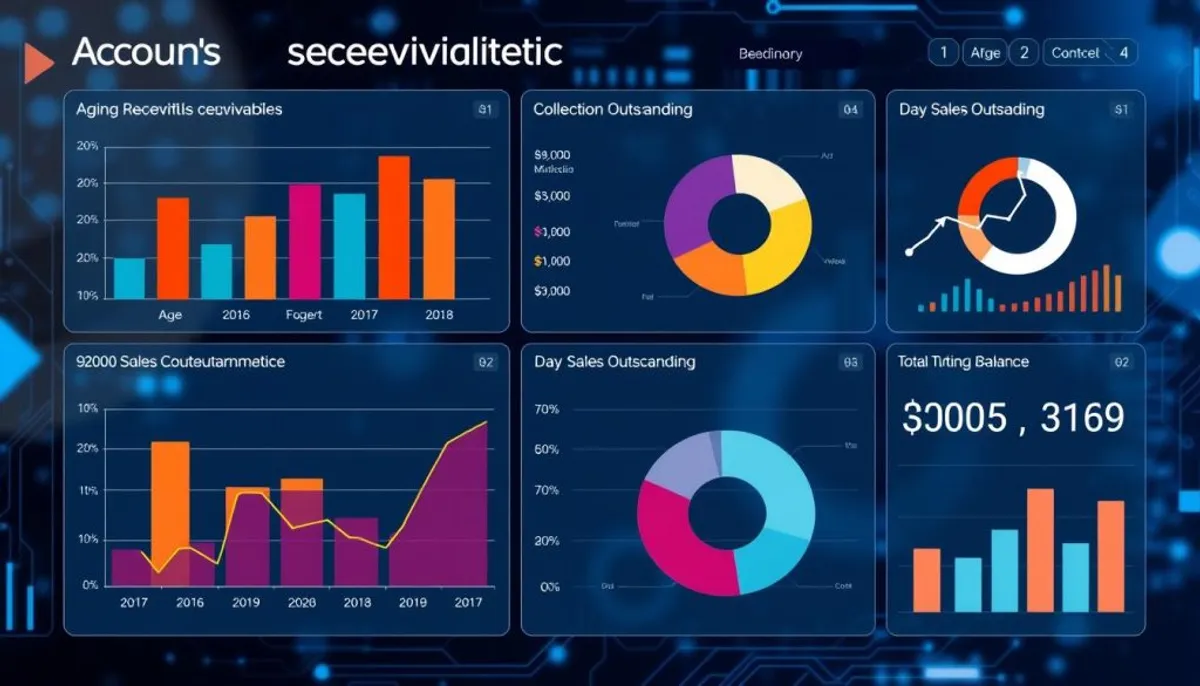In today’s fast-paced business world, managing cash flow is crucial for success. Accounts receivables services play a vital role in optimizing financial operations and driving business growth. By streamlining your AR processes, you can boost your company’s liquidity and pave the way for expansion.
Effective AR management ensures timely payments, fosters positive client relationships, and maintains a healthy cash flow. On the flip side, poor management can lead to wasted time, accounting errors, and lost revenue. The primary goal of AR services is to maximize cash inflow while minimizing costs and enhancing financial relationship management.

By leveraging modern accounts receivables services, businesses can transform their financial operations. These services offer tools for cash flow optimization, automated invoicing, and real-time tracking of payments. With the right AR strategy, companies can reduce late payments, improve customer satisfaction, and fuel sustainable growth.
Key Takeaways
- AR services are essential for maintaining healthy cash flow
- Efficient AR processes lead to timely payments and positive client relationships
- Poor AR management can result in lost revenue and accounting errors
- Modern AR services offer tools for automation and real-time tracking
- Optimizing AR processes can significantly improve business liquidity and growth
Understanding Accounts Receivable Management Fundamentals
Accounts receivables services are vital for maintaining financial health in businesses. They involve tracking client payments through billing, invoicing, and collections. This process is essential for financial management.
Defining Core AR Components
The core of accounts receivable management includes creating invoices, processing payments, and communicating with clients. These components are crucial for ensuring timely payments and reducing the risk of bad debt.
Key Objectives and Goals
The main goals of AR management are to improve billing processes, enhance payment collections, and shorten the time between sales and payments. Effective strategies aim to maintain a healthy cash flow and mitigate financial risks.
| Payment Terms | Description | Impact on Cash Flow |
|---|---|---|
| Net 30 | Payment due within 30 days | Faster cash inflow |
| Net 60 | Payment due within 60 days | Moderate cash inflow |
| Net 90 | Payment due within 90 days | Slower cash inflow |
Impact on Business Cash Flow
Effective accounts receivables services significantly impact cash flow optimization. By ensuring timely payments and reducing unpaid invoice risks, companies can maintain a steady cash flow. This stability is crucial for better financial reporting and informed decision-making.
To gauge AR performance, businesses often use the Days Sales Outstanding (DSO) metric. A lower DSO signifies faster payment collection, which is beneficial for cash flow management. In 2021, XYZ Inc. achieved a remarkable accounts receivable turnover ratio of 30, showcasing prompt customer payments.
The Evolution of Modern Accounts Receivables Services
The realm of accounts receivable has undergone a profound metamorphosis. The erstwhile reliance on paper-based systems has been supplanted by digital AR management. This paradigm shift has profoundly altered the financial management practices of businesses and their interactions with clientele.
Traditional vs Digital AR Management
Historically, AR management was predicated on manual processes. Contemporary digital solutions have streamlined these operations. Electronic billing systems have supplanted paper invoices, while online payments have become the standard. This transformation has diminished errors and expedited cash flow.
| Aspect | Traditional AR | Digital AR |
|---|---|---|
| Invoice Generation | Manual, time-consuming | Automated, quick |
| Payment Processing | Slow, prone to errors | Fast, accurate |
| Data Management | Paper-based, difficult to track | Digital, easily accessible |
Benefits of Electronic Billing Systems
Electronic billing has revolutionized AR management. It facilitates expedited invoice delivery and streamlined payments. Clients can now pay online, significantly reducing payment durations. These systems also automate follow-ups for late payments, enhancing cash flow and minimizing manual intervention.
Integration with Payment Processing
Modern AR services seamlessly integrate with payment processing systems. This integration enables real-time payment tracking and automatic account reconciliation. The outcome is a more efficient and precise AR process. Businesses can now concentrate on expansion rather than payment pursuit.
The transition to digital AR management has yielded substantial advantages. It has enhanced efficiency, reduced errors, and improved customer experiences. As technological advancements persist, we anticipate further innovations in accounts receivable services.
Essential KPIs for Tracking AR Performance
Monitoring key performance indicators (KPIs) is vital for effective financial reporting and optimizing accounts receivable processes. These metrics offer crucial insights into cash flow management and overall financial health.
Days Sales Outstanding (DSO)
DSO gauges the average time to collect payments. A lower DSO signifies faster collection and enhanced cash flow. The formula for DSO is:
DSO = (Accounts Receivable ÷ Total Net Credit Sales) × Number of Days in Period
For instance, with $45,000 in accounts receivable and $80,000 in net credit sales over 90 days, the DSO is 51 days.
Collection Effectiveness Index
This KPI reflects the percentage of accounts collected, indicating the efficiency of collection efforts. A higher index signifies superior performance in recovering outstanding payments.
Accounts Receivable Turnover Ratio
This ratio evaluates how swiftly a company collects payments. The formula is:
AR Turnover Ratio = Net Credit Sales ÷ Average Accounts Receivable
A higher ratio indicates more efficient collection practices. For example, with annual credit sales of $90 million and average accounts receivable of $12 million, the AR turnover ratio is 7.5.
| KPI | Formula | Interpretation |
|---|---|---|
| Days Sales Outstanding (DSO) | (AR ÷ Net Credit Sales) × Days in Period | Lower is better |
| Collection Effectiveness Index | (Beginning AR + Credit Sales – Ending AR) ÷ (Beginning AR + Credit Sales – Ending Current AR) × 100 | Higher is better |
| AR Turnover Ratio | Net Credit Sales ÷ Average AR | Higher is better |

By tracking these KPIs, businesses can pinpoint areas for improvement in their accounts receivable processes. This leads to better cash flow management and financial stability.
Implementing Effective Collection Strategies
Effective debt collection strategies are essential for maintaining a healthy cash flow. Small businesses that excel in managing accounts receivable often employ a structured process for collecting payments. This structured approach aids in identifying potential cash flow issues early, thus preventing financial strain.
Automating receivables significantly accelerates payment processing. Automated invoice reminders and recurring invoices streamline cash flow. Accepting electronic payments through ACH enables clients to pay immediately, further enhancing cash flow.
Offering incentives for early payments can be an effective strategy. A 2/10, net/30 discount encourages clients to settle bills promptly, crucial in industries with tight margins. Implementing late payment penalties can also motivate timely payments.
Tracking and Analysis
Creating an accounts receivable aging report is vital for delinquent account recovery. This report categorizes payments by time frames: 0-30 days, 31-60 days, 61-90 days, and over 90 days. It aids in addressing issues before they escalate.
The Accounts Receivable Turnover Ratio (ART) measures how effectively a business manages its receivables. A high ART indicates efficient collections with few outstanding invoices. A low ART suggests numerous unpaid invoices.
| Strategy | Benefit | Impact on Payment Tracking |
|---|---|---|
| Automated Reminders | Reduces collection time | Improves Days Sales Outstanding |
| Electronic Payments | Speeds up cash flow | Reduces payment delays |
| Early Payment Discounts | Encourages timely payments | Shortens collection cycles |
| Aging Reports | Identifies at-risk accounts | Facilitates proactive interventions |
By implementing these strategies, businesses can optimize their collections process, improve cash flow, and maintain positive client relationships. Regular analysis and adaptation of these methods ensure continued effectiveness in debt collection and payment tracking.
Leveraging Technology for AR Automation
AR automation is transforming accounts receivable management. It leverages advanced technology to streamline financial processes, enhancing efficiency. This innovation replaces outdated methods with more intelligent, rapid operations.
Cloud-Based AR Solutions
Cloud-based solutions provide instant access to financial data. They allow teams to manage invoices and track payments remotely. This technology enables businesses to scale their AR processes easily, accommodating growth and evolving needs.
Automated Payment Reminders
Automated reminders are a significant advancement in invoice processing. They automate follow-ups, eliminating the need for manual intervention. This approach reduces late payments and enhances cash flow. It results in substantial time savings, with some businesses experiencing up to 80% reduction in cash collection time.
Integration with Existing Systems
Seamless integration is crucial for effective AR automation. Modern solutions integrate effortlessly with existing ERP systems. This integration ensures real-time data synchronization across platforms. It fosters a cohesive environment where invoice creation, customer data, and payment tracking are synchronized.
Adopting these technological advancements significantly reduces operational costs. Some businesses achieve over 70% savings in invoicing expenses. The transition from manual to automated processes not only slashes costs but also minimizes errors. It empowers staff to focus on more strategic tasks.
Streamlining Credit Management Processes
Effective credit management is vital for optimizing cash flow and maintaining financial stability. By developing robust strategies, businesses can mitigate risks and ensure timely payments from customers.
Credit Policy Development
A sound credit policy outlines criteria for extending credit to customers. It sets clear payment terms on invoices, encouraging prompt payments. Regular reviews of credit management processes are essential to adapt to business changes and drive continuous improvement.
Risk Assessment Methods
Evaluating creditworthiness involves assessing financial stability and payment history. This process includes monitoring accounts receivable and credit reports for early risk identification. Thorough risk assessment examines industry reputation and financial health to make informed decisions.

Credit Limit Setting
Setting appropriate credit limits aligns with a company’s risk tolerance. This process involves:
- Analyzing customer payment patterns
- Evaluating financial reports
- Considering industry-specific factors
Implementing automation tools like Artsyl docAlpha can streamline credit management processes, reducing time spent on cash collection by up to 80%. These solutions offer features such as automated invoicing and real-time reporting, enhancing efficiency in financial reporting and risk assessment.
Optimizing Customer Communication Channels
Effective customer relationship management relies on clear communication. Businesses can enhance their accounts receivable performance by embracing modern communication channels. Studies reveal that personalized electronic communications boost on-time payments by 40% compared to traditional methods.
Efficiency in invoice processing increases with electronic systems. Companies employing e-billing solutions witness a 75% decrease in days sales outstanding. This approach not only accelerates payment tracking but also elevates customer satisfaction.
Offering diverse contact options is essential. Research highlights:
- 28.65% of customers prefer social media for support
- 41% choose live chat, with satisfaction rates up to 92%
- 90% expect self-service online portals
Adapting to customer preferences is crucial. For Generation Z, SMS and WhatsApp are preferred channels. By offering these options, businesses can cut customer service calls by 20% and enhance payment response rates by 15%.
Automated payment reminders via email or SMS act as gentle nudges. This proactive strategy, combined with clear communication on payment terms, can cut late payments by 35%. It’s worth noting that 72% of customers might switch to a competitor after a single negative experience. This underscores the critical role of optimized communication in retaining customers and ensuring timely payments.
Best Practices in Accounts Receivables Services
Effective accounts receivables services are vital for maintaining a robust cash flow. We will examine crucial strategies to enhance your invoice processing and payment terms.
Invoice Accuracy and Timeliness
Accurate and timely invoices are the cornerstone of efficient accounts receivables services. It is imperative to ensure your invoices are devoid of errors and dispatched without delay. Such practices can notably decrease your Days Sales Outstanding (DSO), which reflects the average time between invoicing and payment receipt.
Payment Terms Optimization
Optimizing payment terms is critical for enhancing cash flow. It is essential to have clear, concise payment terms on all invoices and contracts to avoid misunderstandings and delays. Offering early payment discounts can incentivize quicker payments. This approach can significantly increase your Accounts Receivable Turnover (ART), indicating shorter collection periods.
Dispute Resolution Protocols
Efficient dispute resolution is crucial for maintaining customer satisfaction and preventing payment delays. Establish a clear process for handling disputes and train your team to address issues promptly. This strategy can positively affect your Collections Effectiveness Index (CEI), measuring the percentage of collectible accounts receivable.
| Best Practice | Impact on AR |
|---|---|
| Accurate Invoicing | Reduces DSO |
| Optimized Payment Terms | Improves ART |
| Efficient Dispute Resolution | Enhances CEI |
By adhering to these best practices in accounts receivables services, businesses can streamline their invoice processing, optimize payment terms, and bolster their overall financial health.
Transforming AR with ti3 Platform Solutions
The ti3 platform is transforming accounts receivable management. This innovative SaaS solution simplifies the handling of overdue accounts, offering a novel approach to payment collection.
Automated Payment Collection Features
The ti3 platform revolutionizes the AR process. It dispatches automated reminders to clients, accelerating payment recovery for businesses. This system enables companies to save up to 50 hours each week on invoice preparation. It addresses the 55% rise in late payments experienced by SMEs in the last year.
Customer Relationship Management
Different from traditional collection agencies, the ti3 platform fosters positive client interactions. It employs personalized communication, potentially increasing email open rates by 12%. This method is critical, as 30% of clients may delay payments, potentially straining business relationships.
Real-time Analytics and Reporting
The ti3 platform offers real-time insights into AR performance. This feature is invaluable, given that 49% of U.S. business invoices become overdue. With accurate data at their disposal, businesses can make informed decisions to enhance cash flow.
| Feature | Benefit |
|---|---|
| Automated Reminders | Reduces time spent on collection by 14 hours per week |
| Personalized Communication | Increases email open rates by 12% |
| Real-time Analytics | Helps address 49% of overdue invoices |
By adopting the ti3 platform, businesses can revolutionize their AR processes, boost cash flow, and preserve strong customer relationships. This cost-effective solution presents a compelling alternative to traditional methods, facilitating more efficient financial management.
Conclusion
Effective accounts receivables services are crucial for the financial health of any business. They streamline AR processes, enhancing cash flow and overall financial stability. The shift from traditional to digital AR management has introduced new efficiencies and precision.
Adopting modern strategies, such as automated invoicing and varied payment methods, accelerates payment and reduces errors. Studies indicate that AR management solutions can cut costs by up to 80% per invoice, benefiting high-volume businesses significantly. Proactive communication with customers also ensures timely payments and strengthens relationships.
Success in accounts receivables services hinges on technology, clear credit policies, and ongoing performance monitoring. Metrics like DSO and accounts receivable turnover ratio are key. By embracing these strategies, businesses can optimize their finances, reduce bad debts, and foster sustainable growth in a competitive market.
RelatedRelated articles



